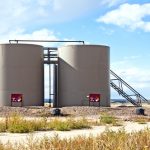How Do Oil Pumpjacks Work?
Oil pumpjacks are large pieces of machinery that extract oil from the ground on a consistent basis. Also known as nodding donkeys or oil horses, they are critical to fossil fuel extraction. Oil pumpjack operation in Carlsbad, NM is a crucial thing to understand if you want to know how these devices work, so let’s explore a quick look into their machinery.
What are they trying to extract?
Oil is not contained in large pools under the ground like you might be picturing. Instead, oil is situated in crevices all throughout underground rock, also known as “pores.” Oil companies’ biggest challenge is finding enough rocks in one place with enough oil embedded in them to make it worth it to install an oil derrick. Once this perfect place is found, oil pumpjack operation in Carlsbad, NM can begin in earnest.
What does the pump do?
A pump is a logical choice for getting the oil out of the ground because oftentimes it is so deep below the surface that any other system is inefficient and impractical. It’s easier to use a pump to draw it out, but it’s not a suction-based pump like you might imagine. Instead, it’s a relatively simple design that allows for artificial lift to bring the oil up to the surface. It uses simple physics and machinery to ensure that a sufficient amount of oil can be brought to the surface on a regular basis, allowing for productive usage of underground resources.
How does it operate?
If you drive by an oil field and see oil derricks pumping up and down, they are in the process of bringing oil to the surface using a plunger system at the bottom of a series of “sucker rods.” This plunger system is capable of bringing up massive amounts of oil over time, and is critical to oil pumpjack operations in Carlsbad, NM. Oil pumpjacks typically have an A-frame base with a horizontal beam at the top, called the “walking beam,” with a “horsehead” at the end that’s attached to the actual pipe descending into the ground. A powered crank turns the walking beam and causes the horsehead to pump up and down.
The horsehead is attached to a sucker rod, which travels down the pipe to the oil reservoir. The sucker rod has a riding valve at the end of it, and the standing valve is situated at the bottom of the pipe. On the downstroke of the horsehead, the standing valve closes and the riding valve opens, putting oil from the previous upstroke on the top side of the riding valve. On the upstroke the riding valve closes and the standing valve opens, which draws oil up the pipeline. The pipeline fills with oil gradually, and oil is pushed to the surface to be stored, typically in large tanks, before needing refining to separate oil from water.
Oil pumpjacks come in all sizes, with larger ones able to go deeper. Oil pumpjacks are crucial to fossil fuel extraction throughout the southern United States, and you can explore our operations in New Mexico to give you a better idea of just how widespread this crucial infrastructure is. Reach out to JB Electric LLC to learn more about our oil field services.
More...
Categorised in: Pump Jack Installation




